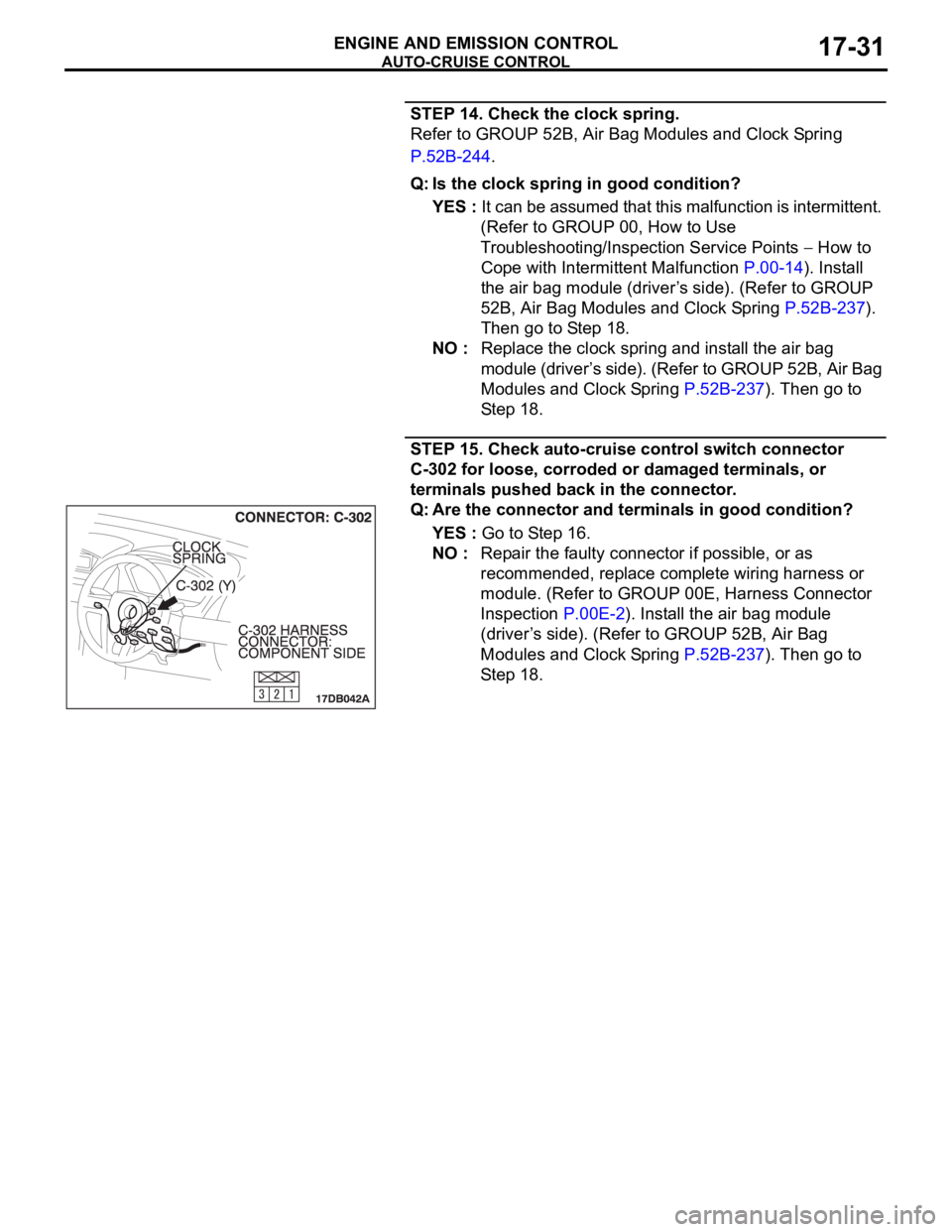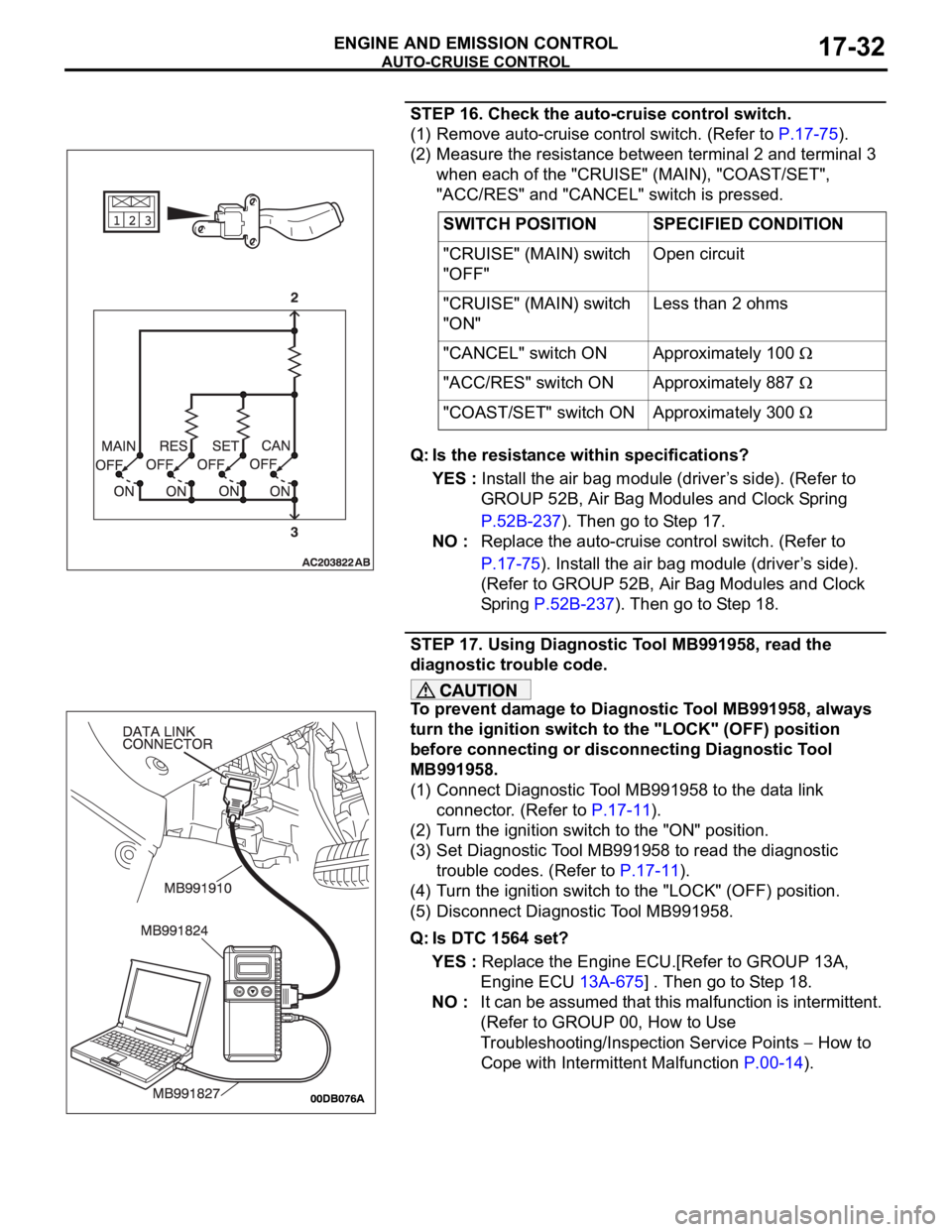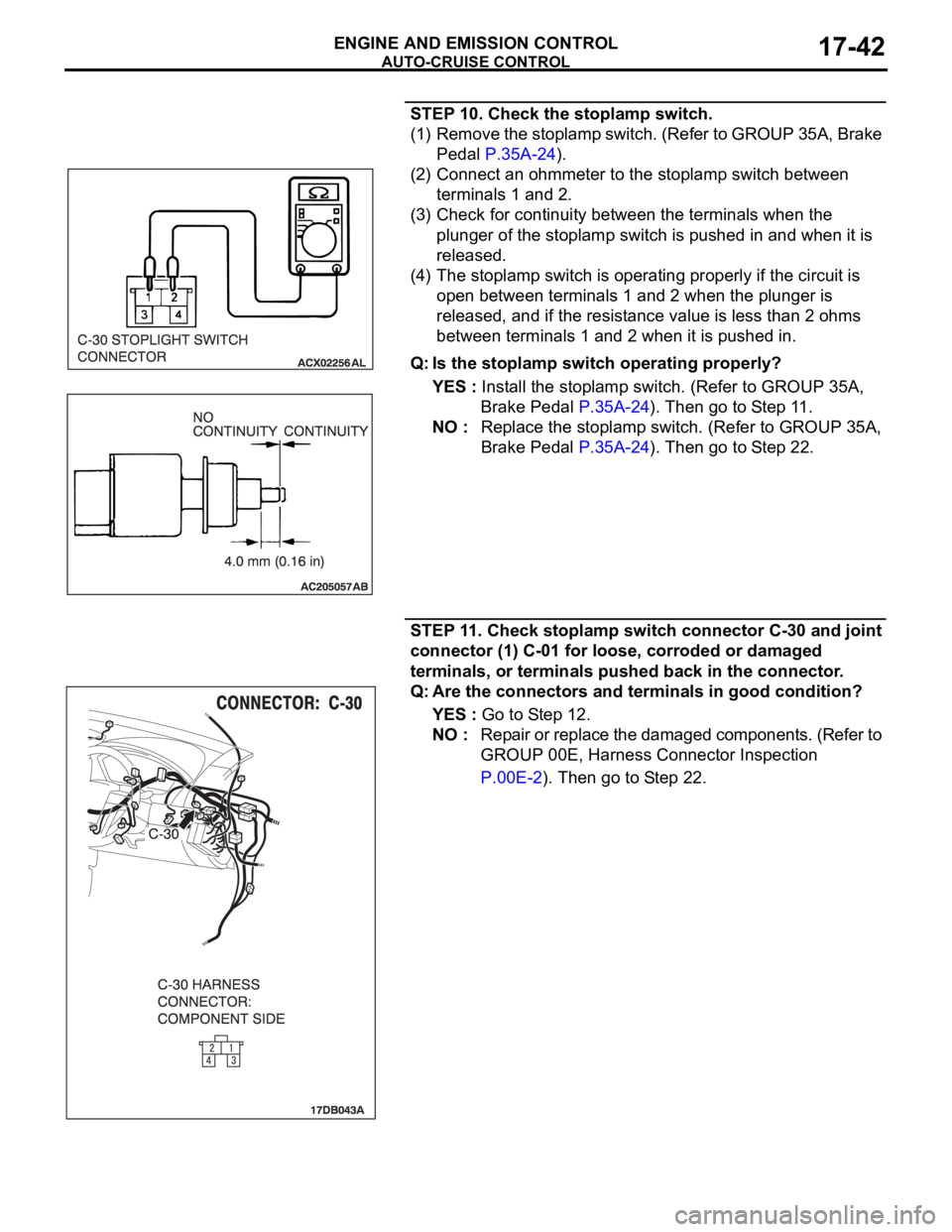Page 1361 of 1500
AUTO-CRUISE CONTROL
ENGINE AND EMISSION CONTROL17-30
Q: Are the connectors and terminals in good condition?
YES : Go to Step 13.
NO : Repair the faulty connector if possible, or as
recommended, replace complete wiring harness.
(Refer to GROUP 00E, Harness Connector Inspection
P.00E-2). Install the air bag module (driver’s side).
(Refer to GROUP 52B, Air Bag Modules and Clock
Spring P.52B-237). Then go to Step 18.
STEP 13. Check the harness wire between Engine ECU
connector B-21 terminal 15 and auto-cruise control switch
connector C-302 terminal 3 for damage.
Q: Are the harness wires in good condition?
YES : Go to Step 14.
NO : Repair the damaged harness wire if possible, or
replace complete wiring harness and install the air
bag module (driver’s side). (Refer to GROUP 52B, Air
Bag Modules and Clock Spring P.52B-237). Then go
to Step 18.
Page 1362 of 1500

AUTO-CRUISE CONTROL
ENGINE AND EMISSION CONTROL17-31
STEP 14. Check the clock spring.
Refer to GROUP 52B, Air Bag Modules and Clock Spring
P.52B-244.
Q: Is the clock spring in good condition?
YES : It can be assumed that this malfunction is intermittent.
(Refer to GROUP 00, How to Use
Troubleshooting/Inspection Service Points
How to
Cope with Intermittent Malfunction P.00-14). Install
the air bag module (driver’s side). (Refer to GROUP
52B, Air Bag Modules and Clock Spring P.52B-237).
Then go to Step 18.
NO : Replace the clock spring and install the air bag
module (driver’s side). (Refer to GROUP 52B, Air Bag
Modules and Clock Spring P.52B-237). Then go to
Step 18.
STEP 15. Check auto-cruise control switch connector
C-302 for loose, corroded or damaged terminals, or
terminals pushed back in the connector.
Q: Are the connector and terminals in good condition?
YES : Go to Step 16.
NO : Repair the faulty connector if possible, or as
recommended, replace complete wiring harness or
module. (Refer to GROUP 00E, Harness Connector
Inspection P.00E-2). Install the air bag module
(driver’s side). (Refer to GROUP 52B, Air Bag
Modules and Clock Spring P.52B-237). Then go to
Step 18.
Page 1363 of 1500

AUTO-CRUISE CONTROL
ENGINE AND EMISSION CONTROL17-32
STEP 16. Check the auto-cruise control switch.
(1) Remove auto-cruise control switch. (Refer to P.17-75).
(2) Measure the resistance between terminal 2 and terminal 3
when each of the "CRUISE" (MAIN), "COAST/SET",
"ACC/RES" and "CANCEL" switch is pressed.
Q: Is the resistance within specifications?
YES : Install the air bag module (driver’s side). (Refer to
GROUP 52B, Air Bag Modules and Clock Spring
P.52B-237). Then go to Step 17.
NO : Replace the auto-cruise control switch. (Refer to
P.17-75). Install the air bag module (driver’s side).
(Refer to GROUP 52B, Air Bag Modules and Clock
Spring P.52B-237). Then go to Step 18.
STEP 17. Using Diagnostic Tool MB991958, read the
diagnostic trouble code.
To prevent damage to Diagnostic Tool MB991958, always
turn the ignition switch to the "LOCK" (OFF) position
before connecting or disconnecting Diagnostic Tool
MB991958.
(1) Connect Diagnostic Tool MB991958 to the data link
connector. (Refer to P.17-11).
(2) Turn the ignition switch to the "ON" position.
(3) Set Diagnostic Tool MB991958 to read the diagnostic
trouble codes. (Refer to P.17-11).
(4) Turn the ignition switch to the "LOCK" (OFF) position.
(5) Disconnect Diagnostic Tool MB991958.
Q: Is DTC 1564 set?
YES : Replace the Engine ECU.[Refer to GROUP 13A,
Engine ECU 13A-675] . Then go to Step 18.
NO : It can be assumed that this malfunction is intermittent.
(Refer to GROUP 00, How to Use
Troubleshooting/Inspection Service Points
How to
Cope with Intermittent Malfunction P.00-14). SWITCH POSITION SPECIFIED CONDITION
"CRUISE" (MAIN) switch
"OFF"Open circuit
"CRUISE" (MAIN) switch
"ON"Less than 2 ohms
"CANCEL" switch ON Approximately 100
"ACC/RES" switch ON Approximately 887
"COAST/SET" switch ON Approximately 300
Page 1369 of 1500
AUTO-CRUISE CONTROL
ENGINE AND EMISSION CONTROL17-38
STEP 4. Check Engine ECU connector B-21 and stoplamp
switch connector C-30 for loose, corroded or damaged
terminals, or terminals pushed back in the connector.
Q: Are the connectors and terminals in good condition?
YES : Go to Step 5.
NO : Repair or replace the damaged components. (Refer to
GROUP 00E, Harness Connector Inspection
P.00E-2). Then go to Step 22.
Page 1370 of 1500
AUTO-CRUISE CONTROL
ENGINE AND EMISSION CONTROL17-39
STEP 5. Check the harness wire between Engine ECU
connector B-21 terminal 18 and stoplamp switch
connector C-30 terminal 1 for damage.
Q: Is the harness wire in good condition?
YES : Go to Step 13.
NO : Repair the damaged harness wire if possible, or as
recommended, replace complete wiring harness.
Then go to Step 22.
Page 1371 of 1500
AUTO-CRUISE CONTROL
ENGINE AND EMISSION CONTROL17-40
STEP 6. Measure the power supply voltage at stoplamp
switch connector C-30 by backprobing.
(1) Disconnect stoplamp switch connector C-30.
(2) Measure the power supply voltage between stoplamp
switch connector C-30 terminal 2 and ground.
(3) Reconnect stoplamp switch connector C-30.
Q: Is the measured voltage battery positive voltage
(approximately 12 volts)?
YES : Go to Step 10.
NO : Go to Step 7.
STEP 7. Check stoplamp switch connector C-30 for loose,
corroded or damaged terminals, or terminals pushed back
in the connector.
Q: Are the connector and terminals in good condition?
YES : Go to Step 8.
NO : Repair or replace the damaged components. (Refer to
GROUP 00E, Harness Connector Inspection
P.00E-2). Then go to Step 22.
Page 1372 of 1500
AUTO-CRUISE CONTROL
ENGINE AND EMISSION CONTROL17-41
STEP 8. Check the harness wire between stoplamp switch
connector C-30 terminal 2 and fuse number 11 at the relay
box at engine compartment for damage.
Q: Is the harness wire in good condition?
YES : Go to Step 9.
NO : Repair the damaged harness wire. Then go to Step
22.
STEP 9. Check the fuse number 11 at the relay box at
engine compartment.
Q: Is the fuse in good condition?
YES : Go to Step 10.
NO : Check the stoplamp system harness and replace the
fuse. Then go to Step 22.
Page 1373 of 1500

AUTO-CRUISE CONTROL
ENGINE AND EMISSION CONTROL17-42
STEP 10. Check the stoplamp switch.
(1) Remove the stoplamp switch. (Refer to GROUP 35A, Brake
Pedal P.35A-24).
(2) Connect an ohmmeter to the stoplamp switch between
terminals 1 and 2.
(3) Check for continuity between the terminals when the
plunger of the stoplamp switch is pushed in and when it is
released.
(4) The stoplamp switch is operating properly if the circuit is
open between terminals 1 and 2 when the plunger is
released, and if the resistance value is less than 2 ohms
between terminals 1 and 2 when it is pushed in.
Q: Is the stoplamp switch operating properly?
YES : Install the stoplamp switch. (Refer to GROUP 35A,
Brake Pedal P.35A-24). Then go to Step 11.
NO : Replace the stoplamp switch. (Refer to GROUP 35A,
Brake Pedal P.35A-24). Then go to Step 22.
STEP 11. Check stoplamp switch connector C-30 and joint
connector (1) C-01 for loose, corroded or damaged
terminals, or terminals pushed back in the connector.
Q: Are the connectors and terminals in good condition?
YES : Go to Step 12.
NO : Repair or replace the damaged components. (Refer to
GROUP 00E, Harness Connector Inspection
P.00E-2). Then go to Step 22.